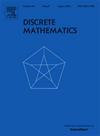最小饱和图没有4周期和5周期
IF 0.7
3区 数学
Q2 MATHEMATICS
引用次数: 0
摘要
给定一组图F,若图G不包含F的副本作为F∈F的子图,则图G是F饱和的,但任意边e的加法e (G)在G内产生至少一个F∈F的副本。有n个顶点的F饱和图的最小大小称为饱和数,记为sat(n,F)。设Cr为长度为r的循环。本文研究了当F是一个循环族时sat(n,F)的性质。特别地,我们确定对于任意正整数n, sat(n,{C4,C5})=≤≤5n4−32;本文章由计算机程序翻译,如有差异,请以英文原文为准。
Minimum saturated graphs without 4-cycles and 5-cycles
Given a family of graphs , a graph G is said to be -saturated if G does not contain a copy of F as a subgraph for any , but the addition of any edge creates at least one copy of some within G. The minimum size of an -saturated graph on n vertices is called the saturation number, denoted by . Let be the cycle of length r. In this paper, we study on when is a family of cycles. In particular, we determine that for any positive integer n.
求助全文
通过发布文献求助,成功后即可免费获取论文全文。
去求助
来源期刊

Discrete Mathematics
数学-数学
CiteScore
1.50
自引率
12.50%
发文量
424
审稿时长
6 months
期刊介绍:
Discrete Mathematics provides a common forum for significant research in many areas of discrete mathematics and combinatorics. Among the fields covered by Discrete Mathematics are graph and hypergraph theory, enumeration, coding theory, block designs, the combinatorics of partially ordered sets, extremal set theory, matroid theory, algebraic combinatorics, discrete geometry, matrices, and discrete probability theory.
Items in the journal include research articles (Contributions or Notes, depending on length) and survey/expository articles (Perspectives). Efforts are made to process the submission of Notes (short articles) quickly. The Perspectives section features expository articles accessible to a broad audience that cast new light or present unifying points of view on well-known or insufficiently-known topics.
 求助内容:
求助内容: 应助结果提醒方式:
应助结果提醒方式:


